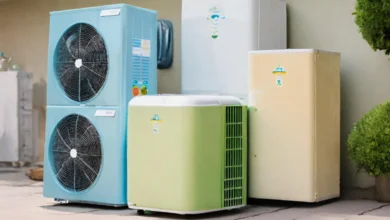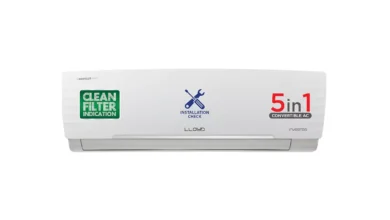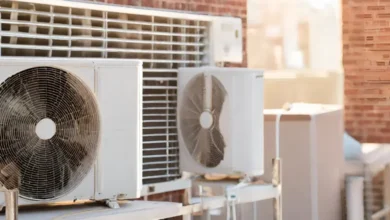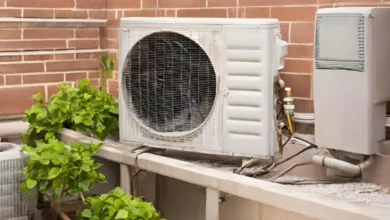Cooling Technology Demystified: How AC Systems Work
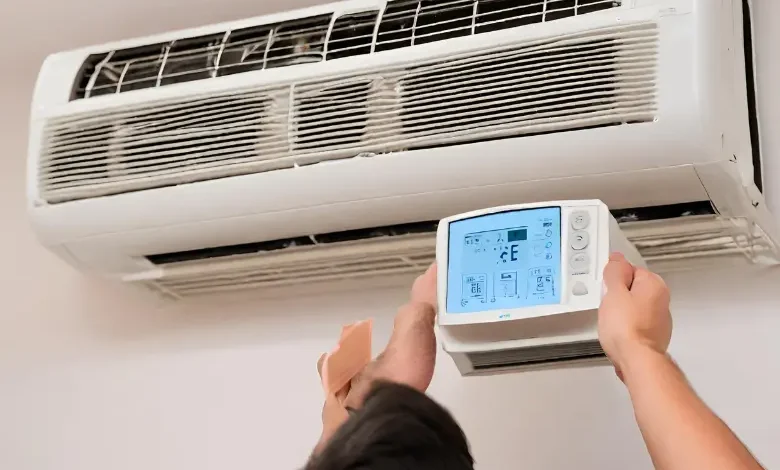
In the sweltering heat of summer, air conditioning (AC) systems emerge as the saviors of our indoor comfort. The mechanisms behind these systems may seem intricate and elusive, but fear not, as we embark on a detailed journey into the fascinating world of cooling technology. In this comprehensive exploration, we’ll unravel the complexities of how air conditioning systems work, breaking down each component’s role in transforming hot air into a refreshing cool breeze.
Also read: Best AC in India 2024
1. Introduction to Air Conditioning: Beyond the Cool Comfort
Before delving into the technicalities, it’s essential to understand the primary purpose of air conditioning. It’s not merely about creating a cool environment; rather, it’s a sophisticated process involving the circulation, filtration, and conditioning of air to maintain a comfortable temperature and humidity level. The goal is to create an optimal indoor climate for human comfort and well-being.
2. The Core Components: Compressor, Condenser, Expansion Valve, and Evaporator
At the heart of every air conditioning system lies a set of core components, each with a unique role in the cooling process. Understanding these components is crucial to demystifying the technology.
2.1. Compressor: Initiating the Cooling Cycle
The compressor serves as the starting point of the cooling cycle. It takes in low-pressure, low-temperature refrigerant gas and compresses it, transforming it into a high-pressure, high-temperature gas. This process is analogous to the heartbeat of the system, setting the entire cycle into motion.
The compressor’s role is pivotal, as it pressurizes the refrigerant, preparing it for the subsequent stages of the cooling process.
2.2. Condenser: Releasing Heat into the Atmosphere
As the high-pressure gas exits the compressor, it enters the condenser coils, a critical component responsible for releasing accumulated heat into the atmosphere. These coils facilitate the transfer of heat from the refrigerant to the surrounding air, causing the gas to condense into a high-pressure liquid.
The condenser is like the stage where the system sheds the heat absorbed from the indoor space, preparing the refrigerant for the next phase.
2.3. Expansion Valve: Regulating Refrigerant Flow
The expansion valve acts as a regulator, controlling the flow of the refrigerant between the high-pressure liquid and the evaporator. Positioned strategically, this valve reduces the pressure of the liquid refrigerant, ensuring a controlled transition. It’s akin to a choreographer, dictating the pace of the cooling performance.
The expansion valve’s precision is crucial in maintaining the efficiency of the overall system.
2.4. Evaporator: Absorbing Heat and Creating Coolness
The spotlight falls on the evaporator, a key component responsible for absorbing heat from the indoor air. Nestled inside the indoor unit, the evaporator facilitates the rapid evaporation of the low-pressure liquid refrigerant as it passes through its coils.
This phase change from liquid to gas is accompanied by the absorption of heat from the indoor air, creating a cool breeze that is then distributed throughout the living space.
3. The Supporting Cast: Fan, Refrigerant, Thermostat, and Filters
While the core components perform the primary functions, several supporting elements contribute to the overall effectiveness and efficiency of the air conditioning system.
3.1. Fan: Circulating the Cool Air
The fan plays a crucial role in ensuring that the cool air generated by the evaporator reaches every corner of your living space. Positioned in the indoor unit, the fan circulates the conditioned air, promoting even cooling. It’s the maestro that enhances the immersive experience of the cooling symphony.
In the outdoor unit, another fan assists in dissipating heat from the condenser coils, contributing to the overall efficiency of the cooling process.
3.2. Refrigerant: The Cool Medium
The refrigerant serves as the lifeblood of the cooling cycle, undergoing a continuous cycle of compression, condensation, expansion, and evaporation. It shuttles heat away from the indoor space to the outdoors, creating the refreshing coolness we crave.
The choice of refrigerant is critical, with modern systems opting for environmentally friendly options to align with sustainability goals.
3.3. Thermostat: Precision Temperature Control
The thermostat acts as the conductor, interpreting the ambient temperature and signaling the AC system to start or stop based on your desired comfort level. Modern thermostats often come equipped with programmable features, allowing you to customize cooling schedules for different times of the day.
3.4. Air Filters: Purity in Performance
While not directly involved in the refrigeration cycle, air filters play a vital role in maintaining air quality. These filters trap dust, pollen, and other particles, preventing them from circulating in the conditioned air. Regular maintenance and replacement of filters contribute not only to improved indoor air quality but also to the longevity and efficiency of the AC system.
3.5. Smart Technology: Elevating the Experience
In recent years, the integration of smart technology has elevated the cooling experience. Smart thermostats, remote control apps, and connected devices allow users to monitor and control their AC systems with unprecedented convenience. These technological advancements not only enhance user experience but also contribute to energy efficiency.
4. The Cooling Process Unveiled: Step-by-Step Breakdown
Now that we’ve acquainted ourselves with the key components, let’s dive into a detailed breakdown of the step-by-step cooling process:
4.1. Compression: The Compressor’s Pivotal Role
The cooling cycle commences as the compressor pressurizes the low-pressure, low-temperature refrigerant gas. This compression transforms the gas into a high-pressure, high-temperature state, ready for the next stage.
4.2. Condensation: Releasing Heat in the Condenser Coils
The high-pressure gas moves to the condenser coils, where it releases heat to the surrounding air. The refrigerant condenses into a high-pressure liquid as it sheds the heat absorbed from the indoor space.
4.3. Expansion: Controlled Release of Pressure
The high-pressure liquid refrigerant then passes through the expansion valve, which regulates its flow and reduces its pressure. This controlled release of pressure prepares the refrigerant for the upcoming phase – evaporation.
4.4. Evaporation: Creating Coolness in the Evaporator
The refrigerant, now in a low-pressure, low-temperature state, enters the evaporator coils. As it evaporates, it absorbs heat from the indoor air, creating a cool breeze. The conditioned air is then circulated throughout the living space, providing the desired comfort.
4.5. Circulation: Fans in Action
The fans, both in the indoor and outdoor units, play a crucial role in the circulation of air. The indoor fan ensures that the cool air reaches every corner of the
living space, while the outdoor fan assists in dissipating heat from the condenser coils.
4.6. Thermostatic Control: Maintaining the Desired Temperature
The thermostat continuously monitors the ambient temperature. When the temperature reaches the set comfort level, the thermostat signals the system to either start or stop, maintaining precise control over the indoor climate.
4.7. Filtration: Enhancing Indoor Air Quality
While not directly involved in the cooling process, air filters contribute to the overall performance by trapping airborne particles. This filtration process ensures improved indoor air quality and prevents the accumulation of dust and allergens in the system.
4.8. Smart Features: Convenience and Efficiency
Modern AC systems equipped with smart technology offer unprecedented convenience. Users can control and monitor their systems remotely, set customized cooling schedules, and leverage energy-saving features, contributing to overall efficiency.
5. Environmental Considerations: Sustainable Cooling
In the pursuit of technological advancement, environmental considerations have become paramount. The choice of refrigerants, energy efficiency, and sustainable practices in manufacturing are crucial aspects of ensuring that AC systems align with global efforts toward environmental conservation.
5.1. Eco-Friendly Refrigerants: Mitigating Environmental Impact
Traditional refrigerants, such as hydrochlorofluorocarbons (HCFCs) and hydrofluorocarbons (HFCs), have been associated with adverse environmental effects. Modern AC systems are transitioning to eco-friendly refrigerants with lower global warming potential, such as R-32 and R-410A.
The adoption of eco-friendly refrigerants represents a conscientious effort to mitigate the environmental impact of air conditioning.
5.2. Energy Efficiency: The Pursuit of Sustainable Cooling
Energy efficiency is a critical factor in the environmental sustainability of AC systems. Higher Seasonal Energy Efficiency Ratio (SEER) ratings indicate greater efficiency, translating to reduced energy consumption and lower environmental impact. Investing in high-efficiency systems contributes to both personal energy savings and a collective effort to reduce greenhouse gas emissions.
6. Challenges and Innovations: Navigating the Future of Cooling Technology
As with any technology, air conditioning systems face challenges that prompt continuous innovation. The industry is witnessing ongoing efforts to address concerns such as energy consumption, refrigerant sustainability, and the environmental impact of manufacturing processes.
6.1. Energy-Efficient Technologies: Advancements in Cooling Efficiency
In the quest for enhanced efficiency, researchers and manufacturers are exploring advanced technologies. Inverter technology, for instance, allows for variable-speed operation of compressors, optimizing energy consumption based on real-time cooling demands. Smart sensors and machine learning algorithms further contribute to intelligent and adaptive cooling solutions.
6.2. Sustainable Manufacturing Practices: Reducing Environmental Footprint
Beyond the operational phase, the manufacturing of AC systems is also undergoing scrutiny for its environmental impact. The industry is increasingly adopting sustainable practices, including the use of recycled materials, energy-efficient manufacturing processes, and responsible waste disposal.
7. Conclusion: The Intersection of Comfort and Technology
In conclusion, the demystification of cooling technology reveals a sophisticated interplay of components working harmoniously to create the comfort we associate with air conditioning. From the rhythmic pulsations of the compressor to the cool breeze generated by the evaporator, each element contributes to the symphony of cooling.
As technology continues to evolve, the future of air conditioning holds exciting possibilities. Innovations in energy efficiency, eco-friendly practices, and smart technologies promise not only enhanced comfort but also a more sustainable approach to cooling our indoor spaces. As consumers, understanding the intricacies of cooling technology empowers us to make informed choices, contributing to both personal well-being and environmental responsibility.
So, the next time you revel in the cool embrace of your air-conditioned space, take a moment to appreciate the technological marvel that makes it all possible. It’s not just about staying cool; it’s about the intersection of comfort and cutting-edge technology, creating an oasis of relief in the midst of summer’s heat.

